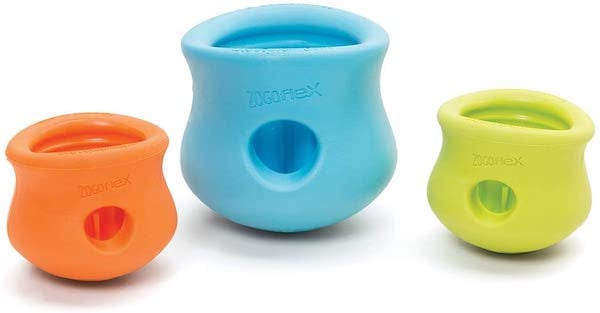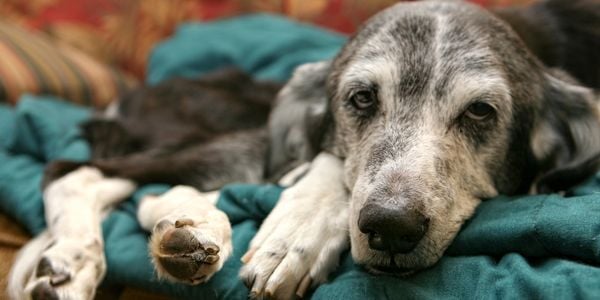
Life seems to be an endless series of questions. It is a constant who, what, when, where, and why. Is it this or that?
And even if we get those initial questions answered, those answers seem to generate even more questions.
This endless menagerie of questions is likely what you experience when you take your pet to the vet when they are sick.
We, veterinarians, tend to ask LOTS of questions, all in hopes of gathering as many pieces of the puzzle as possible so that we can figure out the full picture.
Many symptoms that pets experience can have multiple causes. By getting answers to their questions, veterinarians can narrow down the list of causes and help your pet feel better sooner.
Vomiting is a common clinical sign for MANY diseases or issues, and it is one of the most common reasons pets visit their veterinarian. And what makes it even trickier is that "vomiting" isn't always throwing up — sometimes it’s regurgitation (or, as it’s more affectionately known, “regurge”).
It is understandable that the two are often thought to be the same thing when you consider that the synonyms in the dictionary for regurgitation are vomit, vomit up, barf, spew, etc. But knowing the difference can be quite important. Especially since some of the causes can be life-threatening and require immediate medical attention.
Throwing up and regurge may look (and even smell) the same, but they are two very different processes, and they are medical signs of two very different sets of potential problems in both cats and dogs.
There are ways, although often subtle, to tell the difference between the two. Knowing the difference can help you determine what your next steps should be.
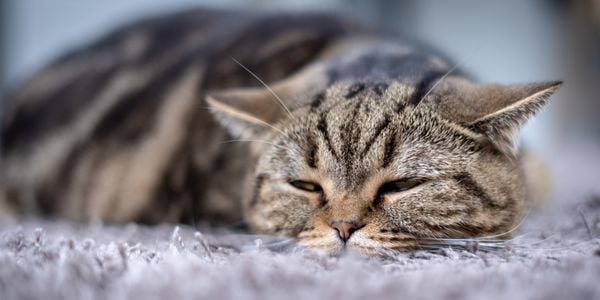
When to Go to the Vet for Vomiting or Regurgitation
If your cat or dog is bringing up food, water, or other “material” more than once per week — regardless of whether it’s vomiting or regurgitation — it’s time for a visit to your veterinarian. They can help you get to the bottom of what’s causing the problem. Treatment for either condition is dependent on the cause.
As an added "gift" to your vet, try capturing a short video of one of the episodes on your phone and, if possible, a sample of it (ideally in a covered plastic container). Then bring that video and sample with you to your vet appointment — it’ll help your vet figure out what’s going on because a picture is worth a thousand words!
Questions Your Veterinarian May Ask
When you go to the vet, try to have as much information as possible to share with them. While it may be kinda gross (kidding, it is really gross), being able to describe the characteristics of the "substance" in question, the timing of it in relation to when your pet ate, and how your pet was acting prior to the incident will help your veterinarian narrow down it if is vomiting or regurge and what the more specific diagnosis may be.
For example, if you know that your pet vomited food and it was at least 6 to 8 hours after eating (their stomach should have been empty), this gives your vet the clue that an obstruction may be present, or the stomach muscles may have an abnormal motion.
You know your pet best and the circumstances surrounding their "vomiting" episode, so every detail is important to share.
For more guidance on how to help your pet if they are vomiting, read about what to do for dogs and what to do for cats.
Regurgitation vs Vomiting in Dogs and Cats
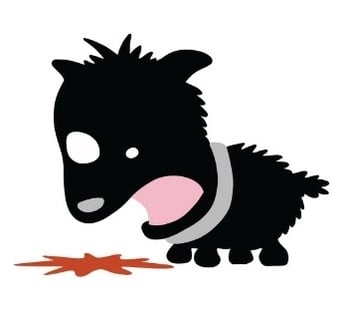
Vomiting: An active process. It's the forceful ejection of material from the stomach or upper part of the intestines. It is an active process, typically accompanied by heaving and contraction of the abdominal muscles. We all know the misery!
And you often get a "warning" before it happens with that “wake you up out of bed” noise (the retching or stomach gurgling) before they spew. It's often, though not always, accompanied by lip licking, pacing, excessive drooling, whining, or anxiety-like behavior.
Vomit may also contain bile (green liquid) or digested food. It can occur at variable times after eating and even happen when pets are off food (lack or loss of appetite).
Regurgitation: A passive process. Regurgitation is typically a very passive process where the contents of the esophagus are ejected. Generally, it occurs right after eating, and the contents can be just water or undigested food in a tubular shape that is often covered in a slimy mucus.
And your pet will sometimes try to ‘clean’ it up by eating it – again! There really isn’t any noise associated with regurge; it’s much stealthier — quietly occurring and often only discovered when you step in the results. Imagine your pet vomiting without retching or any contractions of the abdominal muscles. Typically, there aren’t any signs of nausea either. Rather a cat or dog just lowers their head and out falls the food or other material.
The Medical Differences Between Vomiting and Regurgitation
Vomiting typically indicates a problem with either the stomach or intestines or even a non-gastrointestinal system (see list below) within the body.
Regurgitation predominately points to a problem specifically with the esophagus (the muscular tube that connects the mouth to the stomach).
So, differentiating vomiting from regurgitation is important because they point to a very different set of potential problems. Below are some (partial) lists of problems that can cause vomiting and regurgitation.
Causes of Vomiting in Dogs and Cats
- Stomach or intestinal ulcers, inflammation (IBS), or obstruction (foreign body, intussusception, GDV in dogs)
- Inflammation of the pancreas (read more about pancreatitis in dogs and pancreatitis in cats)
- Kidney disease (infection, stones, obstruction)
- Liver disease (inflammation, infection, tumors)
- Medications or supplements being given
- Pain (anywhere within the body)
- Increased pressure within the skull (tumors, swelling from trauma)
- Hormonal disorders (Addison’s disease, hyperthyroidism, out-of-control diabetes/DKA)
- Bladder obstruction or rupture
- Infectious agents (canine distemper, canine parvovirus, feline panleukopenia)
- Toxins (insecticides, antifreeze, chemicals)
- Parasites
- Dietary indiscretion
- Food allergies
- Diseases of the inner ear
- Ingestion of really large amounts of fur during grooming (hairballs in cats are different again from vomiting)
Eating too fast: There are instances where perfectly healthy dogs and cats can vomit from eating too fast or regurge as a result of eating something TOO big. To help eliminate the risk of vomiting from eating too fast, consider using a slow-feeder bowl. Also, be sure to give the appropriately sized chew toy for the size of your pet, and be sure to supervise them during play.
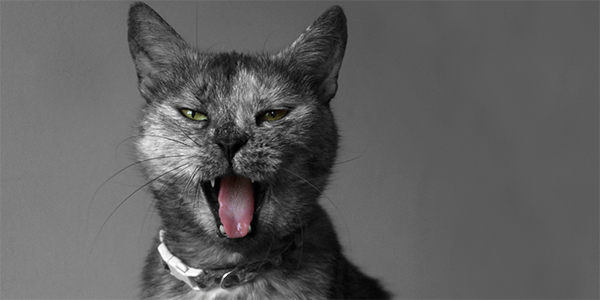
Causes of Regurgitation in Dogs and Cats
- Megaesophagus (ME) is the most common cause of regurgitation
- This condition is hereditary in Wire Haired Fox terriers and Miniature Schnauzers
- Dog breeds predisposed to ME:
- German Shepherd
- Shar-pei
- Great Dane
- Irish Setter
- Greyhound
- Newfoundland
- Labrador Retriever
- Cat breeds predisposed to ME:
- Siamese
- Inflammation of the esophagus (esophagitis)
- Esophageal dysmotility disorder
- Myasthenia Gravis (MG)
- Vascular Ring Anomaly/Persistent Right Aortic Arch
- Foreign body (something stuck) in the throat
- Benign or malignant tumors within or just outside the esophagus
- Stricture (abnormal narrowing) of the esophagus from esophageal disease or trauma
- Hiatal hernia
- Esophageal worms (Spirocerca lupi)
NOTE: Brachycephalic (flat-faced) breeds of dogs and cats are predisposed to a variety of esophageal diseases (like idiopathic esophageal dysmotility, gastroesophageal reflux, esophagitis) that may result in regurgitation.
Brachycephalic dogs:- Bulldog (French and English)
- Boxer
- Boston terrier
- Lhasa Apso
- Pekingese
- Pug
- Shih Tzu
- Bullmastiff
- Burmese
- Himalayan
- Persian
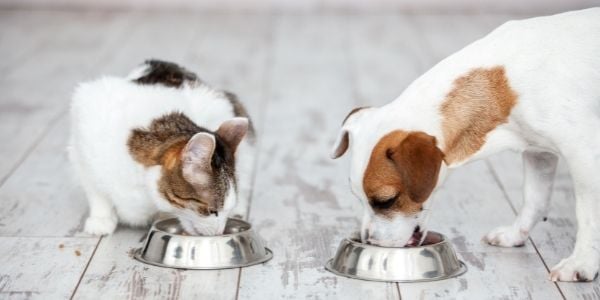
Slowing Down Your Pet's Eating Can Help With Vomiting
If you suspect eating too quickly is causing your pet's bouts of vomiting, then you may want to consider using a slow feeder. There are many interactive feeders and food puzzles to choose from to help slow down your pet's eating. Here are some of our favorites.
Slow Feeders for Dogs
West Paw's Toppl is our ultimate favorite – made of toxic-free materials. It is soft on teeth and easy to clean in the dishwasher. It works well with soft food, as well as kibble. For best results with kibble, we suggest combining a large and small Toppl together so the kibble trickles out more slowly.
Other good choices of slow feeders are this LickiMat wobble bowl, which is dishwasher safe, the Green Feeder (seen in our video of Loki below), and the Kong Wobbler.
Slow Feeders for Cats
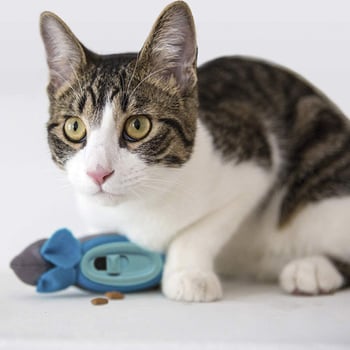
This no-bowl indoor hunting cat feeder system is a great way to get your cat hunting and working for their food. These little, stuffable, plastic "mice" are just too much for cats to resist!
Licky mats are good to use with wet food, moistened dry food, and wet/moist treats.
The Company of Animals makes a smaller cat version of their feeder, like the green one featured in the video above. For cats, it simulates hunting through grass, and they have to use their paws, which makes it a more enriching experience for them.
All these feeder options will help slow down your cat's eating.



